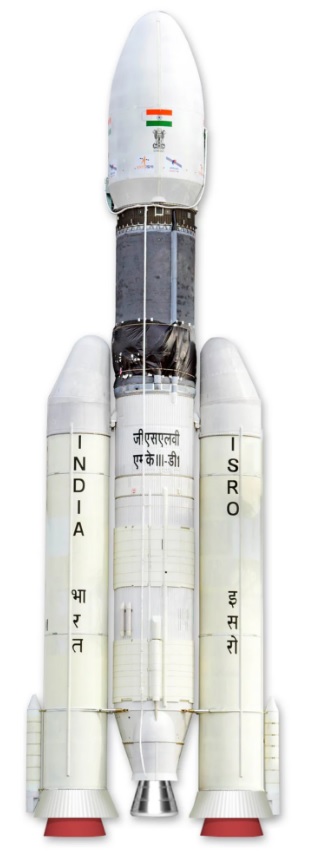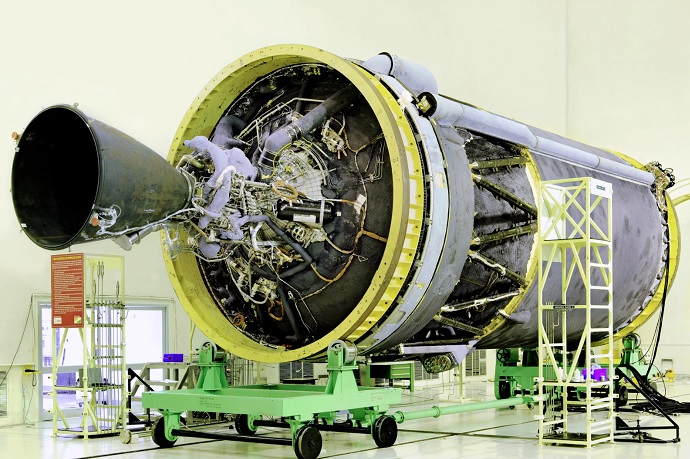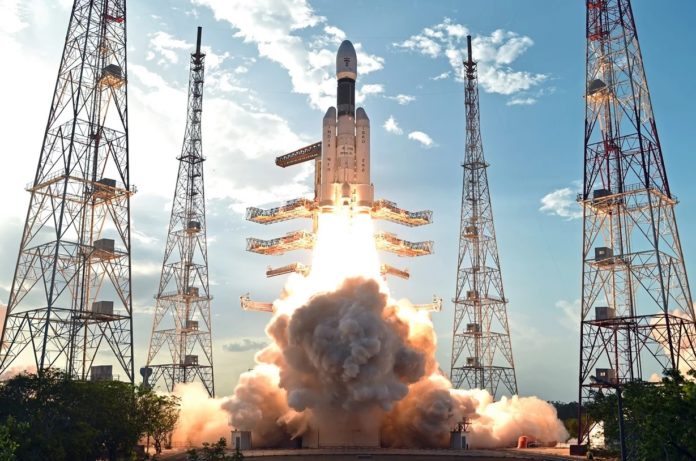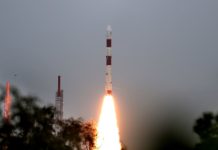On, 5 June 2017 at 5.28pm Indian Standard Time, the Indian Space Research Organisation’s (ISRO) heaviest launch vehicle to date made its maiden developmental launch, carrying the 3136 kg GSAT-19 satellite into orbit.
Officially named the Geosynchronous Satellite Launch Vehicle Mark III (GSLV Mk III-D1) and unofficially dubbed “Fat Boy” because of its size, the launch vehicle is seen as an important milestone in India’s space programme. It is ISRO’s heaviest rocket, with the ability to carry up to 4 tonnes to Geosynchronous Transfer Orbit (GTO) and 10 tonnes to Low Earth Orbit (LEO), twice the load of its predecessor, the GSLV Mk II. With a height of 43.5m and a diameter of 4m, the three-stage launch vehicle uses two strap-on solid boosters, a liquid-fuel second stage and an indigenous cryogenic upper stage.
The vehicle’s cryogenic upper stage engine has received much publicity for representing a breakthrough in ISRO’s capabilities. The 5 June launch was the first time this indigenously-developed engine was used; its success boasts of ISRO’s ability to execute perfectly in its first attempt, adding yet another record-breaking feat to a portfolio which includes its Mars Orbiter Mission (MOM) launched on 5 November 2013, and its launch of a whopping 104 satellites on February 15 this year.
An overview of cryogenic upper stage engines
Although the development of a cryogenic upper stage is indeed a technical challenge, India is not the first country to have acquired the know-how to build one. The USA, Russia (carried over from the Soviet Union), France, China and Japan have also developed such engines, and even ISRO had previously developed a much smaller version, the CE-7.5, which is a component of the GSLV Mk II and was used to launch the GSAT-14 satellite in January 2014.

Developing and manufacturing cryogenic engines is considered a challenge for a number of reasons, one of which is the extremely low temperatures that need to be achieved and maintained for the fuel to be stored in a liquid form. In the case of the GSLV Mk III’s cryogenic stage, which is designated C25 and uses a CE-20 engine, these fuels are liquid oxygen and liquid hydrogen, the most common fuels used for such engines. To accommodate these fuels, special tanks need to be manufactured, which is challenge to materials science – the Space Shuttle Columbia disaster in 2003, for example, occurred because a piece of insulating foam that was meant to protect the cryogenic external tank had broken off.
However, cryogenic engines are also much more efficient. They are able to generate greater thrust more efficiently, sending heavier payloads higher into orbit. Because of this, heavy-lift launch vehicles such as United Launch Alliance’s (ULA’s) Delta IV Heavy (the highest capacity rocket in operation), the Ariane 5 ECA, China’s Long March 5 and the USA’s retired Space Shuttle, all incorporate cryogenic engines in one or more stages.
The road to a cryogenic engine: The politics and economics of space
ISRO began to progress beyond sounding rockets in 1980, when it successfully launched the Satellite Launch Vehicle (SLV) for the first time. In the mid-80s, the organisation decided on eventually developing a launch vehicle that could put a satellite into the geostationary orbit, which has culminated in the GSLV family of rockets.
Thus began ISRO’s sordid quest for a cryogenic engine, which is related in detail in an article written by Rakesh Krishnan Simha titled “How India’s cryogenic programme was wrecked”, published 4 December 2013 in Russia & India Report.
The entire affair is mired in geopolitics, complete with all the ingredients worthy of an exciting spy novel – competing superpowers, secret deals, sanctions, intelligence agencies, and even a framed scientist seeking justice 20 years on.
The technological saga for a cryogenic engine really began when the last leader of the Soviet Union, Mikhail Gorbachev, offered to transfer the technology to India for non-military uses.
This was after deals fell through between India and Japan, Arianespace and General Dynamics respectively, because of pricing issues.
At that point, the Soviet Union was on the verge of collapse. With the deal looking tenuous, ISRO and the Soviet Union’s space agency, Glavcosmos, came up with an alternative plan – for Glavcosmos to outsource the manufacture of their cryogenic engines to Indian firm Kerala High-Tec Industries (now Brahmos Aerospace Trivandrum). On January 18, 1991, the agreement between ISRO and Glavcosmos was officially signed.
Citing the agreement as a violation of Missile Technology Control Regime (MTCR), US President George Bush slapped sanctions on ISRO and Glavcosmos in 1992; continued pressure from the succeeding Clinton administration led Russia to withdraw from the 1991 agreement. In January 1994, Russia agreed to provide seven cryogenic engines to ISRO, but without transferring the technical know-how. These engines, known as KVD-1, were used on ISRO’s GSLV Mk I.
ISRO’S DIY strategy is born
In 1994, the same year the seven Russian cryogenic engines were sent to India, ISRO decided to begin developing its own, in an effort to achieve its 1980s aim of launching into geostationary orbits. The project was to be headed by ISRO’s Liquid Propulsion Systems Centre (LPSC), which was set up earlier in 1987 to develop liquid stages for the organization’s Polar Satellite Launch Vehicle (PSLV). LPSC had also been dabbling in cryogenic technology research since the mid-80s, after developing their Vikas engines, which are now used on all of ISRO’s rockets.
Three years later, in 1997, ISRO’s first cryogenic testing facility was commissioned at the ISRO Propulsion Complex at Mahendragiri, Tamil Nadu, which was at the time part of the LPSC. In 2002, work began on a low-thrust, indigenous cryogenic upper stage engine known as the CE-7.5, which utilized Liquid Oxygen and Liquid Hydrogen to achieve a thrust of 75kN and a burn-time of 720 seconds. The CE-7.5 underwent a hot test in 2008, with a failed flight attempt in 2010 due to a malfunction in the fuel booster turbo pump. After modifications to the engine, it was tested in a launch attempt in 2014, which was a success, and accurately put ISRO satellite GSAT-14 into Geostationary Transfer Orbit (GTO).
The CE-7.5, ISRO’s first foray into cryogenic technology, was never meant to be the organization’s final goal, and had always been seen as a step toward a more powerful cryogenic engine – the CE-20. With the success of the CE-7.5 launch in 2014, ISRO began manufacturing the CE-20, giving it only 2 years to perfect it until the launch on June 5 2017.
A completely indigenous engine
Since the very beginning of ISRO’s cryogenic development, the goal was to develop an indigenous engine capable of sending satellites into GTO; however, the CE-7.5, ISRO’s first cryogenic engine, was designed based on the Russian KVD-1. And although the CE-20 is said to be the culmination of many stages, which includes the development of the CE-7.5, it is in reality a totally different engine.
The GSLV Mk III’s upper stage cryogenic engine is completely indigenous from conception to production. The configuration, design, development, of the GSLV Mark III and its components, was entirely the work of ISRO with the help of Indian corporations such as Hindustan Aeronautics Ltd (HAL) and Godrej. According to Times of India, HAL manufactured “structural assemblies and propellant tankages”, including the payload fairing heat shield, while Godrej manufactured the first stage engine and the third stage cryogenic thrust chamber.
The C25, the designated name for the high performance cryogenic stage – with 200 kN thrust in vacuum – is a huge leap from the 75kN of the CE-7.5, which was criticized for being weak.
With this 200 kN of thrust, the C25 is probably the most powerful cryogenic upper stage in existence; other agencies tend to improve a launcher’s overall capability by using more powerful lower stages or by combining two or more engines.
The engine works on a gas generator cycle, which differs from the KVD-1 and CE-7.5 engines which use staged combustion, and has for propellants Liquid Oxygen (LO) stored at 77K and Liquid Hydrogen (LH2) stored at 20K, the two most common propellants for cryogenic engines.
According to ISRO, the C25 was “validated through a series of 200 tests”, including an initial hot tests in Mahendragiri in 2015 and 2016, and a crucial ground test on 25 January 2017. The last test finally made the vehicle ready for launch, after having pushed back the date from the original 2009-2010 plan, to 2016 and finally to June 5 this year.

The future: manned missions and more
On 18 December 2014, ISRO conducted a suborbital test flight of the GSLV Mk III with the first two stages of the vehicle and without its cryogenic stage. The payload for the flight was an experimental crew module known as Crew Module Atmospheric Re-entry Experiment (CARE), which later led to speculation that ISRO is planning a manned mission, although nothing was confirmed by ISRO.
A few days before the launch, ISRO Chairman A S Kiran Kumar spoke to Times of India and said, “GSLV Mk III could in principle be used for manned mission.”
Now, it seems that ISRO is making modifications to the GSLV Mk III in order to ready it for human spaceflight, as well as to lift even heavier satellite classes into GTO. A recent announcement said ISRO will use the existing cryogenic upper stage and replace the second stage with a new, semi-cryogenic engine using kerosene and LO as propellants, which will increase the maximum payload of the GSLV from 4 tonnes to 6 tonnes.
The ability to launch such satellites, it is said, will reduce India’s dependence on other launch service providers, and perhaps also allow India to compete in the global space economy, by providing low-cost launch services for communications satellites.
The next launch of the GSLV Mk III is slated for January 2018, carrying the GSAT-20, India’s first electric-propulsion satellite.







